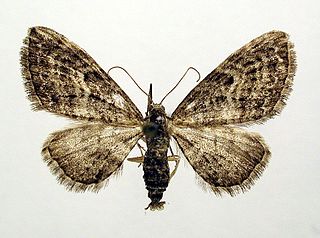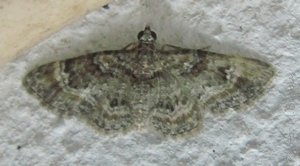
Eupithecia is a large genus of moths of the family Geometridae. There are hundreds of described species, found in all parts of the world, and new species are discovered on a regular basis.

The lime-speck pug is a moth of the family Geometridae. It is a common species throughout the Palearctic region, the Near East and North Africa.

The common pug(Eupithecia vulgata) is a moth of the family Geometridae. It is a common species across the Palearctic region, the Near East and North Africa. It ranges from the Atlantic coast of Ireland and Portugal across Europe, the Middle East and Central Asia to the Russian Far East (Priamurje) and Korea.

The juniper pug or juniper looper is a moth of the family Geometridae. The species was first described by Michael Denis and Ignaz Schiffermüller in 1775. It is found throughout the Palearctic and Nearctic regions and the Near East.

Conocybe is a genus of mushrooms with Conocybe tenera as the type species and at least 243 other species. There are at least 50 different species in North America.

Eupithecia innotata, the angle-barred pug, is a moth of the family Geometridae. The species was first described by Johann Siegfried Hufnagel in 1767. It ranges from Spain in the west to western Siberia and Central Asia in the east.

The larch pug is a moth of the family Geometridae. The species can be found in Europe, the Ural Mountains, West and Central Siberia, the Altai Mountains, Transbaikalia, Yakutia, the Far East, Mongolia, Korea, Japan and in North America, from Yukon and Newfoundland to New York and Arizona.

Eupithecia simpliciata, the plain pug, is a moth of the family Geometridae. It is found in the Palearctic ecozone, from western Europe to north-western China (Xinjiang).

Elimia tenera, formerly known as Goniobasis tenera, is an extinct species of freshwater snail with an operculum, in the aquatic gastropod mollusk family Pleuroceridae. This species flourished during the Eocene and is now known only from the fossil record.

Gymnoscelis, the pugs, is a genus of moths in the family Geometridae described by Paul Mabille in 1868.

Eupithecia venosata, the netted pug, is a moth of the family Geometridae. It was first described by Johan Christian Fabricius in 1787. It is found across the Palearctic ecozone from Portugal and Morocco in the west to the Lake Baikal in Siberia and Afghanistan and Pakistan in the east.

Granigyra tenera is a species of sea snail, a marine gastropod mollusk, unassigned in the superfamily Seguenzioidea.
Alvania tenera is a species of minute sea snail, a marine gastropod mollusc or micromollusk in the family Rissoidae.
Leptasterias tenera is a species of starfish in the family Asteriidae. It is found on the eastern coast of North America.
Eupithecia variostrigata is a moth in the family Geometridae. It is widespread in the western Palaearctic, ranging from Spain to the western Pamirs in the east.
Gogana tenera is a moth in the family Drepanidae first described by Swinhoe in 1902. It is found on Borneo and Peninsular Malaysia.

Eusynthemis tenera is a species of dragonfly of the family Synthemistidae, known as the rainforest tigertail. It is a medium-sized dragonfly with black and yellow markings. It inhabits rainforest streams in north-eastern Australia
Norape tener, the mesquite stinger moth is a moth of the family Megalopygidae. It was described by Herbert Druce in 1897. It is found in south-eastern Arizona, southern New Mexico and Mexico.
Centrodera tenera is a species of flower longhorn in the beetle family Cerambycidae. It is found in North America.

Carex tenera, known as quill sedge, is a species of sedge native to the northern United States and Canada.












